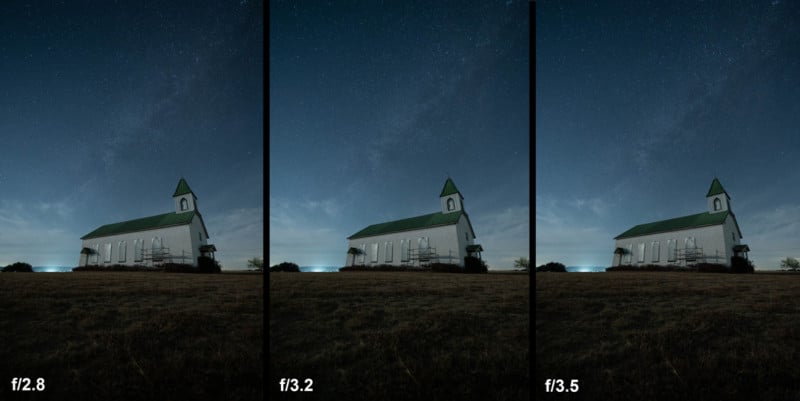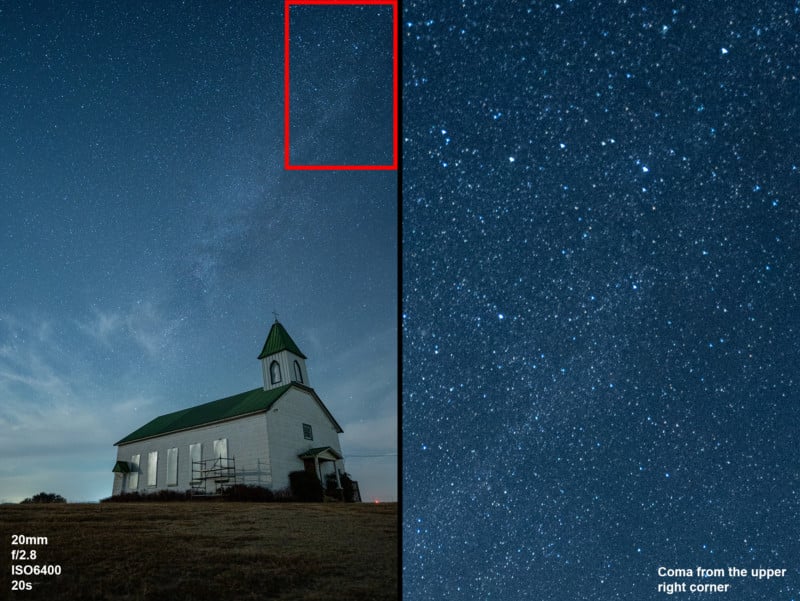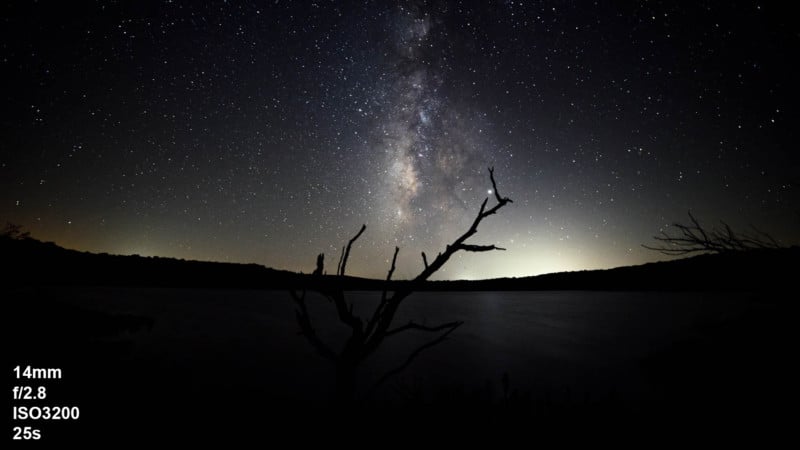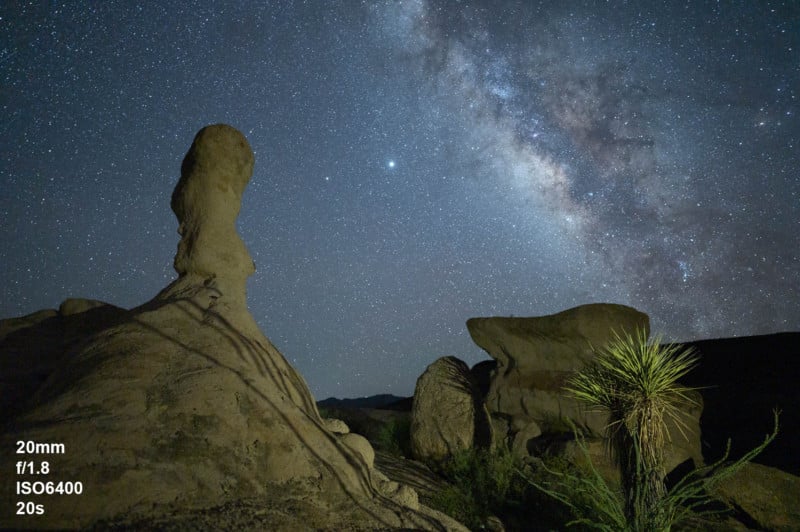Nikon Z 14-24mm f/2.8 S Review for Astrophotography
I took the Nikon Z 14-24mm f/2.8 S out to see how it performed taking astrophotography and nightscape photos with a Nikon Z6. I’ve compiled notes and comparison images to help those out who are looking at purchasing this lens for astrophotography and nightscape photos.
Likes
The wide-angle shooting this lens offers obviously makes it great for shooting the stars due to the exposure times available before the stars start to trail in an image. Beyond the advantages of shooting at 14mm, I found I really enjoyed having the ability to shoot at different focal lengths. For one particular spot, I took images at both 14mm and 20mm without moving my tripod. I ended up loving both images on their own because they provide drastically different perspectives of the same scene. I have only ever shot with prime lenses in the past for nightscapes, so to have the ability to manipulate the photo without swapping lenses and quickly try different compositions is a big plus for me.
![]()
The maximum aperture of f/2.8 is definitely a specification I like on the Nikon Z 14-24mm f/2.8 as it allows enough light to come through the lens to take astrophotography photos. Shooting at f/2.8 and 14mm, I was able to bring in enough light to keep my ISO set to 3200 and get awesome photos with a 25-second exposure. Additionally, until the release of the Nikon Z 14-24mm f/2.8, Nikon only offered the 14-30mm f/4 in terms of a wide-angle lens for the Z series cameras. The 14-30mm easily knocks its self out of the competition for nightscapes with the limited maximum aperture.
The final thing I like about the Nikon Z 14-24mm lens is the superior optics that one would expect from a Nikkor lens. One concern I had with this lens before shooting with it was vignetting at f/2.8. However, I was surprised to find that there wasn’t much noticeable vignetting at f/2.8 and overall, the difference in vignetting between f/2.8, f/3.2, and f/3.5 was minimal. I also found in reviewing my images that coma only seemed to exist in a few bright stars in the corners of a handful of images.

When reviewing my images, I also made sure to take a look at the star trailing in the corners. As expected, there was a little but compared to other lenses like my f mount Rokinon 14mm f/2.8, the Nikon Z 14-24mm is a in a completely different ball park. Overall, the quality of this lens is incredible. Most people who are just looking at these images and not pixel peeping would never notice these small imperfections.
![]() A comparison of the vignetting differences for f/2.8, f/3.2 and f/3.5 aperture settings for astrophotography with the Nikon Z 14-24mm f/2.8 S lens.
A comparison of the vignetting differences for f/2.8, f/3.2 and f/3.5 aperture settings for astrophotography with the Nikon Z 14-24mm f/2.8 S lens.
Dislikes
The first night I took the Z mount 14-24mm out for astrophotography, I was dumbfounded by the first couple of photos trying to figure out why all of my photos were out of focus even though the focus showed infinity on the LCD. I’ve shot in the dark with both my 24-70mm kit lens and a Z mount 20mm in the past with no problem using the digital manual focus. With this lens, however, I found it really hard to dial in the true infinity focus point because of how jumpy the manual focus is while turning the focus ring. If the focus was smooth, I don’t think I would have as much of an issue with the digital focus. I also realized that spinning the dial past the infinity point marked on the LCD actually took the focus a little further and was a contributing factor to my unfocused images. I also would have liked to see the infinity point that shows on the scale in the view finder actually represent infinity in order to not cause confusion to the user. Overall, I wish Nikon had stuck with a mechanically based system for manual focus.

Another dislike for me on the Z Mount 14-24mm lens is easily the price: currently $2,396. I came to that opinion from the standpoint that I was out evaluating this lens only with respect to shooting astrophotography and nightscapes. I get that the 14-24mm gives the user a range to choose from and every location shot at will have a slightly different need based on the composition available, but if a buyer is only wanting to use this lens for astrophotography I think there are more economical options such as the Nikon Z 20mm f/1.8 and the Rokinon 14mm f/2.8. Where I am willing to back off of my opinion a little bit is if the user is someone who plans to also use the 14-24mm for other photography genres. At that point, the lens serves more than one purpose and trying to buy two separate wide-angle lenses to fit multiple needs adds up to a comparable price point of the 14-24mm.
My final dislike on the Nikon Z 14-24mm f/2.8 is more of a big wish from Nikon: f/2.8 is more than enough aperture to get great shots of the Milky Way, which is why I listed the maximum aperture as one of the specs I like about this lens, however, I really fell in love with shooting at f/1.8 when I tested out the 20mm lens a few months back. So again, if the user is someone only shooting nightscapes and astrophotography I think f/2.8 is a bit of a limitation on this lens, but if they are trying to use it for multiple roles I think it’s worth the compromise.
Alternatives
As mentioned multiple times, there are alternative lenses I think one should look into before deciding on this lens solely for astrophotography and nightscapes. If budget is a big deciding factor and someone just wants to get out and try Milky Way photography, I think the Rokinon Z mount 14mm f/2.8 is a great starter lens. The Rokinon lenses (Samyang depending on your location) are known for having more vignetting and coma than other more expensive lenses. At a price point often under $400 when on sale, the Rokinon option makes for an impressive starter lens.

The other lens I would highly recommend taking a look at is the Nikon Z 20mm f/1.8 S. Because of the f/1.8 max aperture, this lens is a workhorse for astrophotography due to the extra light that can make its way to the camera’s sensor when compared to f/2.8. Although it doesn’t have the range of focal lengths like the 14-24mm, I think 20mm is still a great focal length to shoot at for nightscapes and can make for some more intimate photos with the Milky Way. Finally, the 20mm lens comes at a much lower price point around the $1000 mark. That’s well under 50% of the price of the 14-24mm for a lens that has just as great optics and an improved maximum aperture.

Summing it all up, I think the Nikon Z 14-24mm f/2.8 S lens is a spectacular lens for astrophotography and nightscapes. At the end of the day, it will always come down to a personal choice based on budget and lens preferences. However, the 14-24mm is fantastic for those who can afford it and need a versatile lens for multiple photography genres.
About the author: After a few trips with his wife, Will Chaney realized he was just being a tourist taking photos of everything he could. In 2018, he started studying more about image composition and different photography techniques to get him to where he is today. Will is still learning and does not see that portion of photography ever ending for him. This review was originally posted here.